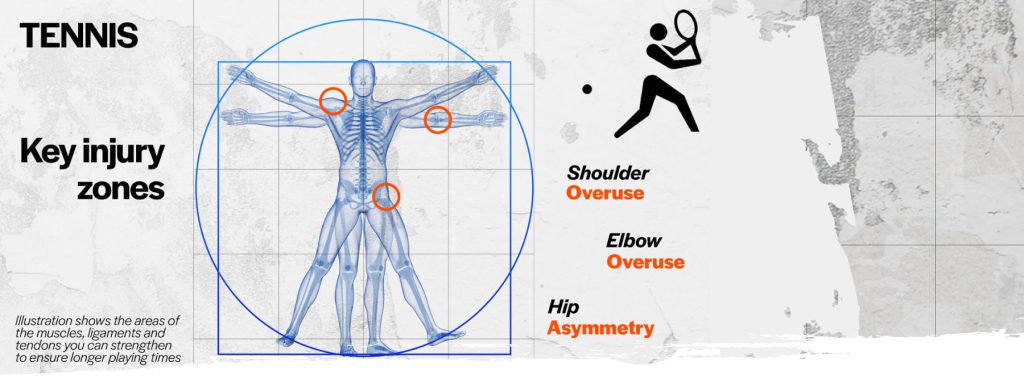Tennis is a (mostly) solo sport which tests your body and mind severely. The pace of each rally is pure adrenaline and can last for entire minutes! That requires immense fitness as well as total focus. Plus, there is no way to know in advance how long a match will last, forcing strategy and pacing to adjust in real time during the match and therefore putting every tennis athlete under great psychological (and physical) pressure.
Also, although not scientifically proven, I have many friends that can promise one thing: when they go on the court and smash it for a couple of hours after a stressful day, it is the perfect anger management session!
Tennis is much safer than many contact sports, since most of the injuries come only from overuse of body parts and never from clashing, dodging or chasing an opponent. According to some studies, it seems to have lower injury rate than other solo sports as well, such as running and golf *.
Tennis Elbow
Every time we perform a forehand hit, we need to retract the wrist and then hit the ball. This joint action is even more marked on a backhand hit, when it’s the wrist extension (called supination) which imparts force on the ball**. This continuous use of the forearm muscle can provoke inflammation. We know it colloquially as tennis elbow, and the scientific name is lateral epicondylitis.
Shoulder
As covered in my basketball blog, your shoulder is a wonder of nature. It can move in pretty much every direction with speed and surprising accuracy. We know though, that its elastic nature makes it susceptible to injuries. In tennis, the cause is overuse. Generally, the most common symptom in young tennis players is instability. Soft cartilage keeps the top of your arm in its socket, but it’s worn down by hard bone***.
 Hip
Hip
Tennis is an “asymmetric” sport. The two sides of our body don’t work equally, since you don’t use one racquet each hand! Every time you flick and hit you use the two sides of your body differently. Of course this will have some (usually) minor consequences, but the hip joint tends to suffer a little more. This is because your hips are surrounded by some of the most powerful muscles you have (hip flexors), and when one of them becomes imbalanced, the pull that it generates is pretty big, and often painful.
Ok, we know all about the injuries, but let’s stay positive and get ready to perfect your tennis body and be the best player you can be with these drills.
EXERCISES
Forearm strength
While sitting, place your forearms, facing up, along your thighs. Leave only the hands hanging off. Hold little weights (a can, a bottle, a tiny dumbbell) and slowly pull wrists towards you and release. Repeat 20 times. 3 sets.

Forearm stretch
To make your wrist as flexible as possible stretch it this way: hold your arm straight out so your elbow isn’t bent and your palm faces up. Use your other hand to hold the fingers of your outstretched hand and bend it down toward your body until you can feel some discomfort in your forearm. Hold it there for 45 seconds. Repeat 4 times each hand.
Shoulder stability
To make your shoulder more stable and ready to support thousands of forehands, backhands and smashes, go into a plank position and hold for about 10 seconds. Then, with minimal movement (especially rotation) from legs, hips or torso, start tapping the opposite shoulder with your hand, alternating. If done very very slowly, perform 10 reps for 5 times.

Hip flexor stretch
At the bottom of a lunge position, relax your knee on the ground. From there, keep your chest nice and high (not leaning back) and push your hips as forward as you can. Hold it for 60 seconds (hip flexors are big muscles remember? It takes a little longer) for 3 times each leg.

References
*Pluim, B. M., Staal, J. B., Windler, G. E., Jayanthi, N. (2006) ‘ Tennis injuries: occurrence, aetiology and prevention’. British Journal of Sports Medicine, 40(5), 415-423
**Elliott, B. (2006) ‘Biomechanics and tennis.’ British Journal of Sports Medicine, 40, 392-396
***Abrams, G., Safran, M. R., Renstrom, P. (2012) ‘Epidemiology of musculoskeletal injury in the tennis player.’ British Journal of Sports Medicine, 1-7







